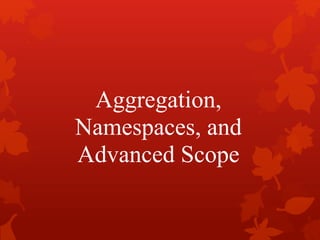
Module 12 aggregation, namespaces, and advanced scope
- 2. Overview Using Internal Classes, Methods, and Data Using Aggregation Using Namespaces Using Modules and Assemblies
- 3. Using Internal Classes, Methods, and Data Why Use Internal Access? Internal Access Syntax Internal Access Example
- 4. Why Use Internal Access? Small objects are not very useful on their own Objects need to collaborate to form larger objects Access beyond the individual object is required public internal private
- 5. Internal Access Comparing access levels Public access is logical Private access is logical Internal access is physical internal
- 6. Syntax internal class <outername> { internal class <nestedname> { ... } internal <type> field; internal <type> Method( ) { ... } protected internal class <nestedname> { ... } protected internal <type> field; protected internal <type> Method( ) { ... } } protected internal means protected or internal
- 7. Internal Access Example public interface IBankAccount { ... } internal abstract class CommonBankAccount { ... } internal class DepositAccount: CommonBankAccount, IBankAccount { ... } public class Bank { public IBankAccount OpenAccount( ) { return new DepositAccount( ); } }
- 8. Using Aggregation Objects Within Objects Comparing Aggregation to Inheritance Factories Example Factory
- 9. Objects Within Objects Complex objects are built from simpler objects Simpler objects are parts of complex whole objects This is called aggregation CarWhole Part EngineChassis Wheel 1 41
- 10. Comparing Aggregation to Inheritance Aggregation Specifies an object relationship A weak whole-to-part dependency Dynamically flexible Inheritance Specifies a class relationship A strong derived-to-base dependency Statically inflexible Part Whole Base Derived
- 11. Factories Creation is often complex and restricted Many objects are made only in specialist factories The factory encapsulates the complex creation Factories are useful patterns when modelling software
- 12. Factory Example public class Bank { public BankAccount OpenAccount( ) { BankAccount opened = new BankAccount( ); accounts[opened.Number( )] = opened; return opened; } private Hashtable accounts = new Hashtable( ); } public class BankAccount { internal BankAccount( ) { ... } public long Number( ) { ... } public void Deposit(decimal amount) { ... } }
- 13. Using Namespaces Scope Revisited Resolving Name Clashes Declaring Namespaces Fully Qualified Names Declaring using-namespace-directives Declaring using-alias-directives Guidelines for Naming Namespaces
- 14. Scope Revisited The scope of a name is the region of program text in which you can refer to the name without qualification public class Bank { public class Account { public void Deposit(decimal amount) { balance += amount; } private decimal balance; } public Account OpenAccount( ) { ... } }
- 15. Resolving Name Clashes Consider a large project that uses thousands of classes What if two classes have the same name? Do not add prefixes to all class names // From Vendor A public class Widget public class VendorAWidget { ... } { ... } // From Vendor B public class Widget public class VendorBWidget { ... } { ... }
- 16. Declaring Namespaces namespace VendorA { public class Widget { ... } } namespace VendorB { public class Widget { ... } } namespace Microsoft { namespace Office { ... } } namespace Microsoft.Office { } shorthand
- 17. Fully Qualified Names A fully qualified class name includes its namespace Unqualified class names can only be used in scope namespace VendorA { public class Widget { ... } ... } class Application { static void Main( ) { Widget w = new Widget( ); VendorA.Widget w = new VendorA.Widget( ); } }
- 18. Declaring using-namespace- directives Effectively brings names back into scope using VendorA.SuiteB; class Application { static void Main( ) { Widget w = new Widget( ); } } namespace VendorA.SuiteB { public class Widget { ... } }
- 19. Declaring using-alias-directives Creates an alias for a deeply nested namespace or type using Widget = VendorA.SuiteB.Widget; class Application { static void Main( ) { Widget w = new Widget( ); } } namespace VendorA.SuiteB { public class Widget { ... } }
- 20. Guidelines for Naming Namespaces Use PascalCasing to separate logical components Example: VendorA.SuiteB Prefix namespace names with a company name or well- established brand Example: Microsoft.Office Use plural names when appropriate Example: System.Collections Avoid name clashes between namespaces and classes
- 21. Using Modules and Assemblies Creating Modules Using Assemblies Creating Assemblies Comparing Namespaces to Assemblies Using Versioning
- 22. Using Modules .cs files can be compiled into a (.netmodule) managed module csc /target:module Bank.cs
- 23. Using Assemblies Group of collaborating classes Reusable, versionable, and secure deployment unit Physical access control at assembly level Internal an assembly of four classes public internal private
- 24. Creating Assemblies Creating a single-file assembly Creating multifile assembly csc /target:library /out:Bank.dll Bank.cs Account.cs csc /t:library /addmodule:Account.netmodule /out:Bank.dll Bank.cs
- 25. Comparing Namespaces to Assemblies Namespace: logical naming mechanism Classes from one namespace can reside in many assemblies Classes from many namespaces can reside in one assembly Assembly: physical grouping mechanism Assembly MSIL and manifest are contained directly Assembly modules and resources can be external links
- 26. Using Versioning Each assembly has a version number as part of its identity This version number is physically represented as a four- part number with the following format: <major version>.<minor version>.<build number>.<revision>
- 27. Review Using Internal Classes, Methods, and Data Using Aggregation Using Namespaces Using Modules and Assemblies